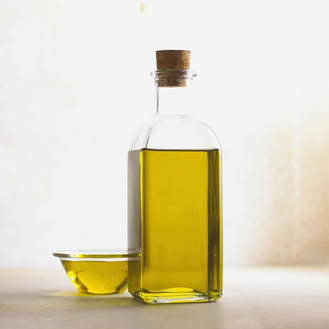
Myths abound in our understanding of this most important category of foods.
There are hundreds of fatty acids and the ones the body cannot make on its own are called essential fatty acids. Fats store energy, insulate and protect our organs. They act as messengers and start reactions that control growth, immune function, reproduction and other aspects of metabolism. No one really understands yet how our bodies store and make fat and call it into action. Yet we know that fats are vital for life - for the luster and glow of eyes, skin and hair that radiate health and vitality
There are hundreds of fatty acids and the ones the body cannot make on its own are called essential fatty acids. Fats store energy, insulate and protect our organs. They act as messengers and start reactions that control growth, immune function, reproduction and other aspects of metabolism. No one really understands yet how our bodies store and make fat and call it into action. Yet we know that fats are vital for life - for the luster and glow of eyes, skin and hair that radiate health and vitality
Quality counts

Back in the 1960’s all fat, especially saturated fat, was considered unhealthy. The first Framingham Heart Study, begun in 1948, identified high cholesterol as a risk factor for heart disease. Eggs were considered bad and low-fat was “in”. Research continues to this day at Framingham and elsewhere and today we much understand more.
In order to make sense of understanding fats we have to understand their molecular structure. There are hundreds of fatty acids; they are all chains of carbon atoms with mostly hydrogen atoms bonded to them, or an occasional oxygen atom or hydroxyl compound (one hydrogen atom and one oxygen atom bonded together).
In order to make sense of understanding fats we have to understand their molecular structure. There are hundreds of fatty acids; they are all chains of carbon atoms with mostly hydrogen atoms bonded to them, or an occasional oxygen atom or hydroxyl compound (one hydrogen atom and one oxygen atom bonded together).
Saturated vs. Unsaturated
Chains and bonds can be visualized by imagining a fat molecule as a train.. The aisle of the train represents a chain of carbon atoms and the “seats” on both sides can be empty or filled with hydrogen or oxygen atoms. The longer the chain of carbon atoms the harder the fat will be to digest. If there are double bonds between any of the carbon atoms, the fat will also be far more complex and difficult to break down. It also means that the seats adjacent to the double bonded carbon atoms will be empty. Fats can be small chain, medium chain or long chain and saturated or unsaturated.
Butyric acid, which gives butter its name, is the shortest chain fatty acid. (See diagram below) Butyric acid has just four carbon atoms with hydrogen atoms in the “seats” except the last which is bonded with one oxygen atom and one hydroxyl compound (OH). We will write this as C4:0 meaning butyric acid has 4 carbons atoms and no double bonds. Butyric acid is saturated, meaning there are no empty seats on the train. Being the shortest of all fats, it is quickly digested and used for energy; it has great intestinal permeability which is probably a source of its healing properties. It may be why ghee, or clarified butter, is so revered in Ayurveda and why it can penetrate so deeply and quickly into tissues.
Butyric acid, which gives butter its name, is the shortest chain fatty acid. (See diagram below) Butyric acid has just four carbon atoms with hydrogen atoms in the “seats” except the last which is bonded with one oxygen atom and one hydroxyl compound (OH). We will write this as C4:0 meaning butyric acid has 4 carbons atoms and no double bonds. Butyric acid is saturated, meaning there are no empty seats on the train. Being the shortest of all fats, it is quickly digested and used for energy; it has great intestinal permeability which is probably a source of its healing properties. It may be why ghee, or clarified butter, is so revered in Ayurveda and why it can penetrate so deeply and quickly into tissues.
Butyric acid is just four carbon atoms bonded with hydrogen atoms, one oxygen atom and one hydroxyl (OH) compound. It is also written as CH3CH2CH2-COOH.
Other saturated fats are lauric acid, C12:0, which means there are 12 carbon atoms or 12 rows in the chain and no double bonds. Oleic acid, the principal fatty acid of olive oil, C18:1 is a long chain fatty acid with one double bond carbon atom. Double bonds give a kink to the chain which is why unsaturated fats are generally liquid - the kinks create spaces that prevent the fatty acids from lining up neatly like building blocks the way saturated fats do.
Food sources of fat are composed of many different fatty acids. In general, animal sources of fat are usually saturated and plant sources are usually unsaturated. There are some notable exceptions, coconut being one. Coconut oil is almost half lauric acid (C12:0). The shorter chain of lauric acid allows it to activate mitochondria, the energy producing part of our cells. It gets used for energy rather than stored which is why it is helpful for people trying to lose weight. Lauric acid also has anti-viral properties; smaller fats can dissolve lipid layers around viruses, which kills them.
Human milk has a fat content of between 2% - 10%. Mother’s milk is important for many reasons, one of which is it contains lauric acid. it also contains butyric acid (C4:0), about 30% oleic acid and about 23% palmitic aid (C16:0).
Other saturated fats are lauric acid, C12:0, which means there are 12 carbon atoms or 12 rows in the chain and no double bonds. Oleic acid, the principal fatty acid of olive oil, C18:1 is a long chain fatty acid with one double bond carbon atom. Double bonds give a kink to the chain which is why unsaturated fats are generally liquid - the kinks create spaces that prevent the fatty acids from lining up neatly like building blocks the way saturated fats do.
Food sources of fat are composed of many different fatty acids. In general, animal sources of fat are usually saturated and plant sources are usually unsaturated. There are some notable exceptions, coconut being one. Coconut oil is almost half lauric acid (C12:0). The shorter chain of lauric acid allows it to activate mitochondria, the energy producing part of our cells. It gets used for energy rather than stored which is why it is helpful for people trying to lose weight. Lauric acid also has anti-viral properties; smaller fats can dissolve lipid layers around viruses, which kills them.
Human milk has a fat content of between 2% - 10%. Mother’s milk is important for many reasons, one of which is it contains lauric acid. it also contains butyric acid (C4:0), about 30% oleic acid and about 23% palmitic aid (C16:0).

Oleic acid (C18:1), which has 18 carbon atoms in its chain and only one double bond, is often considered the healthiest fat of all and is found in butter, eggs, avocados and olive oil. In fact, olive oil, which gave oleic oil its name, is about 70% oleic acid. It is called mono-unsaturated because it has just one double bond in its structure: poly-unsaturated oils have more than one double bond. .Double bonds in unsaturated fatty acids leave them vulnerable to reactive molecules, like oxygen, that break up the chains and make the fat rancid. That’s why proper storage of fats and oils is so important. Dark glass bottles are preferred storage containers to shield the oil from sunlight and cool, dark cupboards or pantries are preferred locations.
So are saturated fats the villains they were made out to be? What more recent research seems to suggest is that high cholesterol and heart disease may have more to do with the absence of phytonutrients that help metabolize fats, an improperly functioning immune system, and chronic inflammation, than the consumption of fat, especially saturated fat. There just is no evidence that saturated fat increases the risk of coronary heart disease.
So are saturated fats the villains they were made out to be? What more recent research seems to suggest is that high cholesterol and heart disease may have more to do with the absence of phytonutrients that help metabolize fats, an improperly functioning immune system, and chronic inflammation, than the consumption of fat, especially saturated fat. There just is no evidence that saturated fat increases the risk of coronary heart disease.
Coming next
The scoop on trans fats



